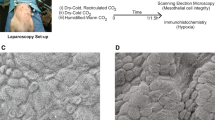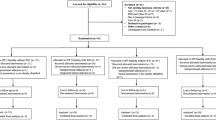Abstract
Background
Increased peritoneal blood flow may influence the ability of cancer cells to adhere to and survive on the peritoneal surface during and after laparoscopic cancer surgery. Carbon dioxide (CO2) pneumoperitoneum is associated with a marked blood flow increase in the peritoneum. However, it is not clear whether the vasodilatory effect in the peritoneum is related to a local or systemic effect of CO2.
Methods
In this study, 21 pigs were exposed to pneumoperitoneum produced with either CO2 (n = 7) or helium (He) (n = 7) insufflation at 10 mmHg for 4 h, or to two consecutive levels of hypercapnia (7 and 11 kPa) (n = 7) produced by the addition of CO2 to the inhalational gas mixture. Tissue blood flow measurements were performed using the colored microsphere technique.
Results
Blood flow in peritoneal tissue increased during CO2, but not He, pneumoperitoneum, whereas it did not change at any level of hypercapnia alone. There was no change in blood flow in most organs at the partial pressure of CO2 (PaCO2) level of 7 kPa. However, at a PaCO2 of 11 kPa, blood flow was increased in the central nervous system, myocardium, and some gastrointestinal organs. The blood flow decreased markedly in all striated muscular tissues during both levels of hypercapnia.
Conclusion
The effect of CO2 on peritoneal blood flow during laparoscopic surgery is a local effect, and not attributable to central hemodynamic effects of CO2 pneumoperitoneum or high systemic levels of CO2.


Similar content being viewed by others
References
Åneman A, Svensson M, Stenqvist O, Dalenbäck J, Lönroth H (2000) Intestinal perfusion during pneumoperitoneum with carbon dioxide, nitrogen, and nitric oxide during laparoscopic surgery. Eur J Surg 166: 70–76
Arellano R, Jiang MT, O’Brien W, Hossain I, Boylen P, Demajo W, Cheng DCH (1999) Acute graded hypercapnia increases collateral coronary blood flow in a swine model of chronic coronary artery obstruction. Crit Care Med 27: 2729–2734
Bannister LH (ed) (1995) Alimentary system. In: Williams PL (chair ed board) Gray’s anatomy. 38th ed. Churchill Livingstone, New York, pp 1734–1746
Bauer R, Walter B, Wurker E, Kluge H, Zwiener U (1996) Colored microsphere technique as a new method for quantitative-multiple estimation of regional hepatic and portal blood flow. Exp Toxicol Pathol 48: 415–420
Brundell SM, Tsopelas C, Chatterton B, Touloumtzoglou J (2002) Experimental study of the peritoneal blood flow and insufflation pressure during laparoscopy. Br J Surg 89: 617–622
Diebel L, Saxe J, Dulchavsky S (1992) Effect of intraabdominal pressure on abdominal wall blood flow. Am Surg 58: 573–575
Folkman J (1971) Tumor angiogenesis: therapeutic implications. N Engl J Med; 285: 1182–1186
Heyman MA, Payne BD, Hoffman JIE, Rudolph AM (1977) Blood flow measurements with radionuclide-labeled particles. Prog Cardiovasc Dis 20: 55–79
Hsu P, Albuquerque MLC, Leffler CW (1995) Mechanisms of hypercapnia-stimulated PG production in piglet cerebral microvascular endothelial cells. Am J Physiol 268: H591–H603
Jacobi CA, Sabat R, Bohm B, Zieren H, Volk HD, Muller JM (1997) Pneumoperitoneum with carbon dioxide stimulates growth of malignant colonic cells. Surgery 121: 72–78
Jakimowicz J, Stultiens G, Smulders F (1998) Laparoscopic insufflation of the abdomen reduces portal venous flow. Surg Endosc 12: 129–132
Kobayashi N, Kobayashi K, Kouno K, Horinaka S, Yagi S (1994) Effects of intraatrial injection of colored microspheres on systemic hemodynamics and regional blood flow in rats. Am J Physiol 266(5 Pt 2): H1910–H1917
Larrieu AJ, Newman GE, Syracuse DC, McClenathan JH, Gaudiani VA, Michaelis LL (1978) The effects of arterial CO2 tension on regional myocardial and renal blood flow: an experimental study. J Surg Res 25: 312–318
Lundberg O, Kristofferson A (2004) Pneumoperitoneum impairs blood flow and augments tumor growth in the abdominal wall. Surg Endosc 18: 293–296
Schmetterer L, Findl O, Strenn K, Graselli U, Kastner J, Eichler HG, Wolzt M (1997) Role of NO in the O2 and CO2 responsiveness of cerebral and ocular circulation in humans. Am J Physiol 273: R2005–R2012
Tunon MJ, Gonzales P, Jorquera F, Llorente A, Gonzalo-Orden M, Gonzales-Gallego J (1999) Liver blood flow changes during laparoscopic surgery in pigs. Surg Endosc 13: 668–672
Vaupel P, Hockel M (2000) Blood supply, oxygenation status, and metabolic micromilieu of breast cancers: characterization and therapeutic relevance. Int J Oncol 17: 869–879
Vaupel P, Kallinowski F, Okunieff P (1989) Blood flow, oxygen and nutrient supply, and metabolic microenvironment of human tumors: a review. Cancer Res 49: 6449–6465
Winer BJ (1971) Statistical principles in experimental design. 2nd ed. McGraw-Hill, Kogagusha, Tokyo
Yavuz Y, Rønning K, Lyng O, Mårvik R, Grønbech JE (2001) Effect of increased intraabdominal pressure on cardiac output and tissue blood flow assessed by color-labeled microspheres in the pig. Surg Endosc 15: 70–76
Yavuz Y, Rønning K, Lyng O, Grønbech JE, Mårvik R (2003) Effect of carbon dioxide pneumoperitoneum on tissue blood flow in the peritoneum, rectus abdominis, and diaphragm muscles. Surg Endosc 17: 1632–1635
Author information
Authors and Affiliations
Corresponding author
Rights and permissions
About this article
Cite this article
Yavuz, Y., Rønning, K., Bakkelund, K. et al. Hemodynamic and tissue blood flow responses to long-term pneumoperitoneum and hypercapnia in the pig. Surg Endosc 20, 1394–1401 (2006). https://doi.org/10.1007/s00464-005-0372-6
Received:
Accepted:
Published:
Issue Date:
DOI: https://doi.org/10.1007/s00464-005-0372-6




